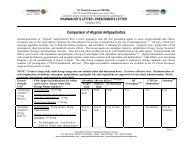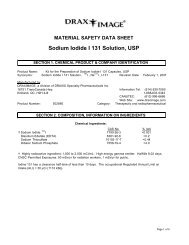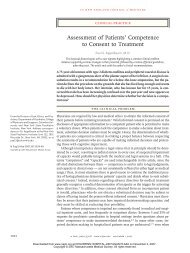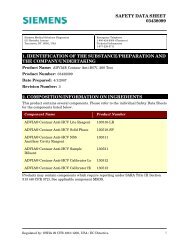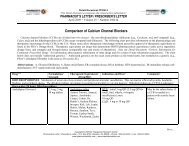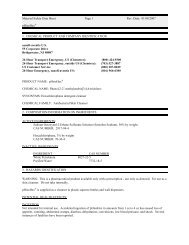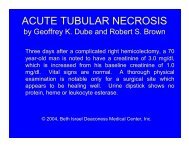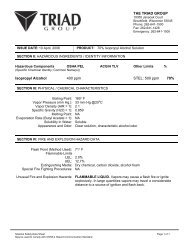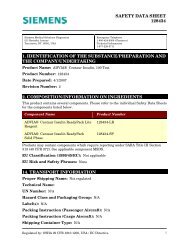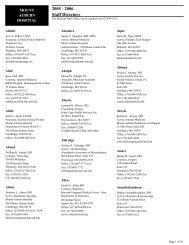ADVIA Centaur Anti-HCV Calibrator Lo
ADVIA Centaur Anti-HCV Calibrator Lo
ADVIA Centaur Anti-HCV Calibrator Lo
You also want an ePaper? Increase the reach of your titles
YUMPU automatically turns print PDFs into web optimized ePapers that Google loves.
SAFETY DATA SHEET130512Siemens Medical Solutions Diagnostics511 Benedict AvenueTarrytown, NY 10591; USAEmergency Telephone1-800-424-9300 (Chemtrec)Technical Information1-877-229-37111. IDENTIFICATION OF THE SUBSTANCE/PREPARATION ANDTHE COMPANY/UNDERTAKINGProduct Name: <strong>ADVIA</strong>® <strong>Centaur</strong> <strong>Anti</strong>-<strong>HCV</strong> <strong>Calibrator</strong> <strong>Lo</strong>Product Number: 130512Date Prepared: 4/1/2007Revision Number: 2Recommended Use: In vitro diagnostic reagent2. COMPOSITION/INFORMATION ON INGREDIENTSCAS-No./EINECS-No.26628-22-8 / 247-852-1Chemical Name Amount EU Classification(67/548/EEC):Sodium Azide 0.09% N, T+, R28, R32,R50/5355965-84-9 / 247-500-7, 220-239-65-Chloro-2-methyl-4-isothiazolin-3-oneand 2-Methyl-4-isothiazolin-3-one(3:1)0.0032% C, N, T, R23/24/25,R34, R43, R50/53See Section 16 for further information on EU Classification.3. HAZARDS IDENTIFICATIONMan: May be harmful by ingestion. May cause sensitization by skin contact. Containsinactive human disease causing material.Environment: This product contains 0.09% sodium azide which is toxic to fish. Thisproduct contains 0.1% Proclin 300 which contains 2.3% 5-Chloro-2-methyl-4-isothiazolin-3-one and 0.8% 2-Methyl-4-isothiazolin--3-one.(Note: This product does contain material derived from human sources and may beconsidered a biohazard and/or Regulated Medical Waste in your state. Check your <strong>Lo</strong>calEnvironmental Regulations.)EU Classification (1999/45/EC): Xi - IrritantEU Risk and Safety Phrases: R43,S24,S37Regulated by: OSHA 29 CFR 1910.1200, USA / EC Directive 1
SAFETY DATA SHEET1305124. FIRST AID MEASURESEmergency First Aid Procedures: Call a physician immediately. Arrange fortransport to the nearest ER (emergency room).While awaiting the physician or transport to the ER:Inhalation: If it occurs move patient to fresh air. If not breathing, give artificialrespiration. If breathing is difficult, give oxygen.Ingestion: If the patient is conscious, wash out mouth with water, give one or two glassesof water or milk to dilute immediately. Get immediate medical attention.Skin Contact: Take off all contaminated clothing immediately. Wash off with soap andplenty of water. Wash contaminated clothing before re-use. Get prompt medical attention.Eye Contact: Rinse immediately with plenty of water, also under the eyelids, for at least15 minutes. Transport to hospital to see an ophthalmologist.5. FIRE-FIGHTING MEASURESExtinguishing Media: Use whatever is required for the surrounding area.Special Fire Fighting Procedures: It is always best to wear a self-containedbreathing apparatus.Unusual Fire and Explosion Hazards: None determined.6. ACCIDENTAL RELEASE MEASURESSteps to be taken in case material is released or spilled: Wear chemicalresistant rubber gloves and laboratory apron. Take up with absorbent material and place ina biohazard container. Wipe up area with a damp paper towel and discard in a biohazardcontainer. Disinfect spill area with a 10% bleach solution.7. HANDLING AND STORAGEStore at temperatures and conditions as indicated on the product label. Handle as a humanserum sample. Prevent contact with the eyes, skin and clothing. Contains inactive humandisease causing material.Regulated by: OSHA 29 CFR 1910.1200, USA / EC Directive 2
SAFETY DATA SHEET1305128. EXPOSURE CONTROLS / PERSONAL PROTECTIONChemical NameSodium Azide5-Chloro-2-methyl-4-isothiazolin-3-one and2-Methyl-4-isothiazolin-3-one (3:1)Exposure Limit(s)0.29 mg/m3 TLV-CeilingNone EstablishedVentilation: Use general room ventilation.Respiratory Equipment: None required.Protective Gloves: Standard laboratory chemical rubber or latex gloves.Eye Protection: Standard laboratory safety glasses recommended. Contact lensesshould not be worn in the laboratory.Other Protective Equipment/Clothing: A laboratory coat or apron is recommended.9. PHYSICAL AND CHEMICAL PROPERTIESAppearance and odor: Clear, colorless to straw colored, aqueous solution.pH: 7.0-7.6Specific Gravity (H2O=1): 1.0Boiling Point (F): N/DMelting Point (F): N/AVapor Pressure: N/DEvaporation Rate: N/DSolubility in Water: SolubleFlash Point (Method Used): NoneFlammable Limits: LEL: Not ApplicableN/A = Not ApplicableN/D = Not Determined10. STABILITY AND REACTIVITYStability: StableConditions to Avoid: None determined.UEL: Not ApplicableSubstances to Avoid: Avoid contact with metals (aluminum, mercury, copper, lead,zinc) and acids.Regulated by: OSHA 29 CFR 1910.1200, USA / EC Directive 3
SAFETY DATA SHEET130512Hazardous Decomposition Products: Sodium azide can react with heavy metals toform explosive azides.Hazardous Polymerization: Will Not Occur11. TOXICOLOGICAL INFORMATIONChronic Effects of Overexposure: None currently known.Carcinogen or Suspected Carcinogen: None of the components are listed as acarcinogen or suspected carcinogen.Medical Conditions Aggravated by Exposure: None currently known.Acute Toxicity:Inhalation: Inhalation of mists may cause respiratory irritation and possible systemiceffects similar to ingestion.Ingestion: Contains human serum or other human source material. Contains inactivehuman disease causing material.Ingestion of sodium azide has been reported to cause shortness of breath, nausea, vomiting,restlessness, diarrhea, lowering of blood pressure (hypotension), and collapse. Rated highlytoxic in animals.Skin Contact: May cause mild irritation. Prolonged and extensive skin contact mayresult in absorption with systemic symptoms similar to ingestion. Contains inactive humandisease causing material.Eye Contact: May cause irritation.Acute Toxicity Values: Sodium Azide: LD50 oral rat: 27 mg/kg; LD50 dermal rabbit:20 mg/kg12. ECOLOGICAL INFORMATIONEcological effects of this mixture have not been determined.The LC50 for sodium azide in Daphnia Pulex is reported to be 4.2 mg/L/96 hr @ 15ºC andin Rainbow Trout is reported to be 0.8-1.6 mg/L/96 hr @ 13ºC, Wt 1.4 G.This product contains Proclin 300. The active ingredients have a 48 hr EC50 of 0.16 ppm inDaphnia Magna and a LC50 in Rainbow Trout of 0.19 ppm.13. DISPOSAL CONSIDERATIONSPrimary Container Type: The product container is polypropylene.Waste Disposal Method: Each disposal facility must determine proper disposalmethods to comply with <strong>Lo</strong>cal, State and Federal Environmental Regulations.Regulated by: OSHA 29 CFR 1910.1200, USA / EC Directive 4
SAFETY DATA SHEET130512EU Classes and Risk Phrases for Reference (See Sections 2 and 3):C - CorrosiveN - Dangerous for the environmentT - ToxicT+ - Very toxicR23/24/25 - Toxic by inhalation, in contact with skin and if swallowed.R28 - Very toxic if swallowed.R32 - Contact with acids liberates very toxic gas.R34 - Causes burns.R43 - May cause sensitization by skin contact.R50/53 - Very toxic to aquatic organisms, may cause long-term effects in the aquaticenvironment.WARNING - POSSIBLE HAZARDOUS MATERIALAny product prepared from human blood, plasma, or serum should be handled cautiously asa hazardous material according to good laboratory practices.If substantial amounts of reagents containing Sodium Azide are disposed of in plumbingsystems, Sodium Azide may build up and form metal azides with copper or lead. This mayproduce a potential explosion hazard. See product insert or "Safety Management No. CDC-22 (United States Center for Disease Control) Decontamination of Laboratory Sink Drainsto remove Azide Salts".Reason for Revision: First issue.Prepared by: Regulatory Affairs DepartmentThe opinions expressed herein are those of qualified experts within Siemens MedicalSolutions Diagnostics. We believe that the information contained herein is current as of thedate of this Material Safety Data Sheet. Since the use of this information and theseopinions and the conditions of use of the product are not within the control of SiemensMedical Solutions Diagnostics, it is the users' obligation to assure safe use of the product.Regulated by: OSHA 29 CFR 1910.1200, USA / EC Directive 6



